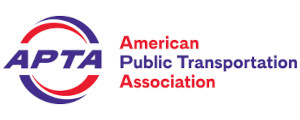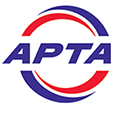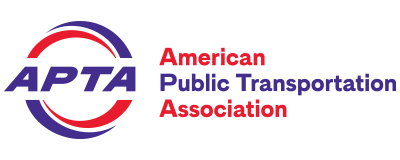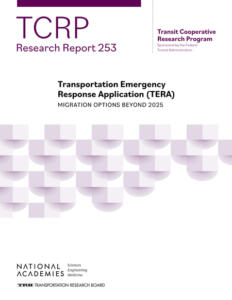
Transportation Emergency Response Application (TERA): Migration Options Beyond 2025
Report Number: R-253
Publication Date: 04/23/2025
The Transportation Emergency Response Application (TERA) is a scenario-based training system that provides training and exercise scenarios and materials for command-level and operational roles in public transportation agencies, state departments of transportation, and airport emergency operations centers for natural and human-made disaster incidents.
This report identifies migration and repurpose options for the content of TERA to one or more platforms and describes materials that have the most value as resources for tabletop exercises.
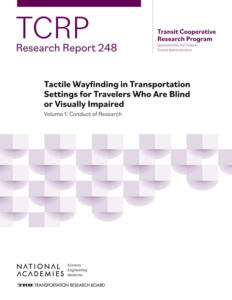
Tactile Wayfinding in Transportation Settings for Travelers Who Are Blind or Visually Impaired, Volume 1: Conduct of Research
Report Number: R-248
Publication Date: 03/17/2025
Travelers who are blind or visually impaired use a variety of cues and strategies to orient themselves within their surroundings and move through space to where they want to go. This wayfinding process can be particularly challenging in complex urban environments where some cues, such as detectable edge treatments, the sound of surging parallel traffic, or other indicators may be inconsistent, confusing, misleading, or missing.
This report seeks to help provide consistency of tactile walking surface indicators and guidelines for their use in multimodal environments. There is a second volume to the report, titled TCRP Research Report 248: Tactile Wayfinding in Transportation Settings for Travelers Who Are Blind or Visually Impaired, Volume 2: Guide.
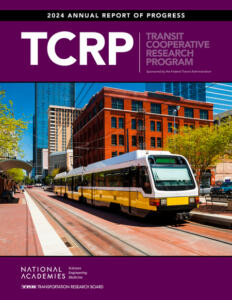
TCRP 2024 Annual Progress Report
Report Number:
Publication Date: 01/02/2025
The TRB Transit Cooperative Research Program (TCRP) has released its annual report, which provides an overview of the program, status of each of TCRP’s projects, and a summary of some of the program’s accomplishments for the year.
TCRP focuses on issues significant to the public transportation industry, with emphasis on developing near-term research solutions to a variety of transit problems involving facilities, vehicles, equipment, service concepts, operations, policy, planning, human resources, maintenance, and administrative practices.
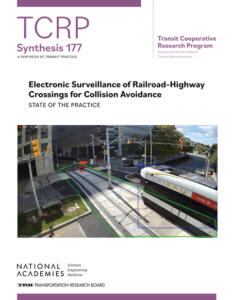
Electronic Surveillance of Railroad-Highway Crossings for Collision Avoidance
Report Number: S-177
Publication Date: 12/05/2024
This report documents public transit agencies’ current practices and lessons learned from rail service providers and others regarding the types, nature, implementations, successes, and failures of rail crossing electronic surveillance programs, particularly related to safety. This synthesis provides insights about the needs, decision criteria, measure of effectiveness, success factors, causes for failures, and selected implementations of rail crossing electronic surveillance programs, primarily for safety. The synthesis also discusses potential future advancements in rail crossing electronic surveillance.
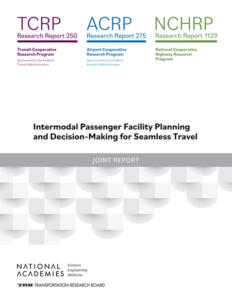
Intermodal Passenger Facility Planning and Decision-Making for Seamless Travel
Report Number: R-250
Publication Date: 11/14/2024
The intermodal travel experience has changed significantly over the past two decades and continues to evolve. The broad adoption of digital technologies has altered how customers plan, book, and pay for travel and navigate spaces. Those that plan, build, and manage intermodal passenger facilities—such as airports, transit centers, rail and bus stations, and ferry and cruise terminals—must consider recent trends and emerging technologies and the impact on the travel experience.
This report describes the state of the practice, emerging lessons, and recommended practices for how intermodal passenger facilities can meet the needs of diverse users in the 21st century as new technologies emerge. The report emphasizes support for seamless travel, considering how different people experience intermodal passenger facilities.
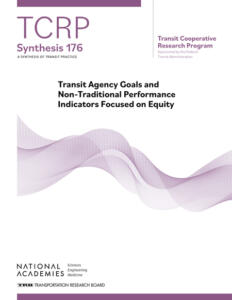
Transit Agency Goals and Non-Traditional Performance Indicators Focused on Equity
Report Number: S-176
Publication Date: 09/24/2024
Historically, ridership has been the primary way transit agencies have communicated their success and public value in making connections for community. Several transit agencies have shifted services and enhanced performance tracking in recent years in ways that relate to the inequities tied to race, ethnicity, national origin, physical ability, income, age, or gender.
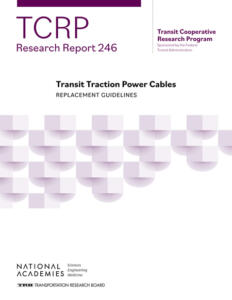
Transit Traction Power Cables
Report Number: R-246
Publication Date: 09/24/2024
Many transit agencies’ conductor insulation systems used for traction power cables and lower voltage power distribution and signal communication systems typically have a 30-year lifespan, and many of these systems are at that age or older.
This report presents current practices for assessing insulation aging and replacement of cables before failure, including approaches used in transit systems for which there are no monitoring programs or testing systems.
Supplemental to the report are TCRP Web-Only Document 77: Developing a Guide for Transit Traction Power Cables and a PowerPoint presentation.
